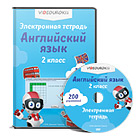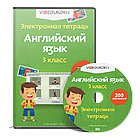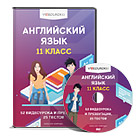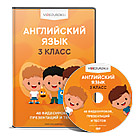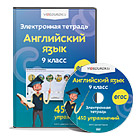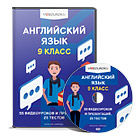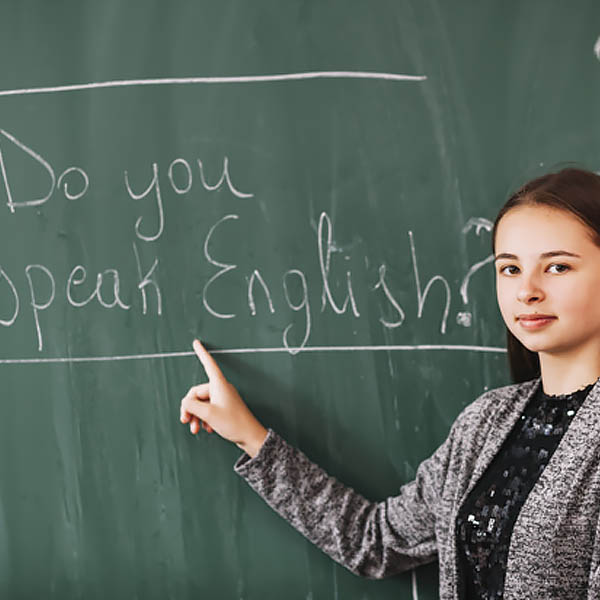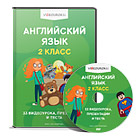FESTIVALS AND CELEBRATIONS IN RUSSIA
 Christmas
Christmas
A long with other religious celebrations, Christmas was banned in Russia after the 1917 Revolution. Russians could only openly observe Christmas in 1992. Almost all Russians celebrate Christmas (the birth of Jesus) on 7 January. It’s mainly a religious occasion and also a public holiday in Russia when families gather together to attend church services on Christmas Eve (6 January). They then go home to feast on a special holy supper. The Christmas Eve meal is typically meatless and can be made up of twelve dishes to represent the twelve apostles. Kutya as one of the main dishes of the Christmas feast is a concoction of grains and poppy seeds sweetened with honey; it is served as one of the main dishes of the Christmas feast. Russian Christmas is spent with family, and is considered a time of forgiveness and love. Thoughtful gifts are given to loved ones, and homes are decorated with figures of angels, stars, and nativity scenes.
long with other religious celebrations, Christmas was banned in Russia after the 1917 Revolution. Russians could only openly observe Christmas in 1992. Almost all Russians celebrate Christmas (the birth of Jesus) on 7 January. It’s mainly a religious occasion and also a public holiday in Russia when families gather together to attend church services on Christmas Eve (6 January). They then go home to feast on a special holy supper. The Christmas Eve meal is typically meatless and can be made up of twelve dishes to represent the twelve apostles. Kutya as one of the main dishes of the Christmas feast is a concoction of grains and poppy seeds sweetened with honey; it is served as one of the main dishes of the Christmas feast. Russian Christmas is spent with family, and is considered a time of forgiveness and love. Thoughtful gifts are given to loved ones, and homes are decorated with figures of angels, stars, and nativity scenes.
 February: Maslenitsa Festival
February: Maslenitsa Festival
S even weeks before Easter are the week-long Maslenitsa festivities – Russia’s pancake week. They combine the pagan tradition of marking the transition from winter to spring with the Christian tradition of feasting before Lent. Each day there are different activities: making Maslenitsa dolls from straw and old clothes, making and eating lots of pancakes (blinis), sledging, playing on seesaws, singing, fistfights, visiting relatives, exchanging gifts and feasting. The Maslenitsa dolls burn on the final day, and people jump over bonfires. Celebrations start the night before Easter Sunday. Churches fill with lights and, at dawn, the bells ring out to announce the arrival of Easter. Everyone paints boiled eggs in bright colors and has a traditional feast.
even weeks before Easter are the week-long Maslenitsa festivities – Russia’s pancake week. They combine the pagan tradition of marking the transition from winter to spring with the Christian tradition of feasting before Lent. Each day there are different activities: making Maslenitsa dolls from straw and old clothes, making and eating lots of pancakes (blinis), sledging, playing on seesaws, singing, fistfights, visiting relatives, exchanging gifts and feasting. The Maslenitsa dolls burn on the final day, and people jump over bonfires. Celebrations start the night before Easter Sunday. Churches fill with lights and, at dawn, the bells ring out to announce the arrival of Easter. Everyone paints boiled eggs in bright colors and has a traditional feast.

8 March: International Women’s Day
Symbolizing women’s equality, most people in Russia refer to International Women’s Day just as ‘the eighth of March’. It’s a day for celebrating women’s achievements. People have time off work, workplaces organize celebrations, and everyone gives gifts to the important women in their lives.
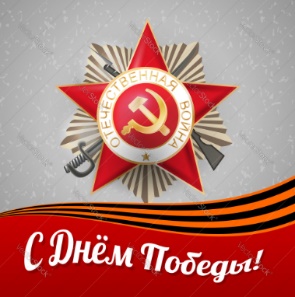
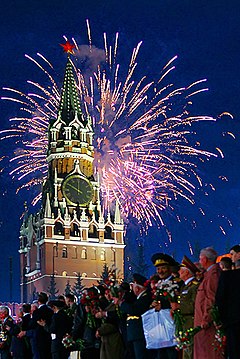 9 May: Victory Day
9 May: Victory Day
Victory Day celebrates the end of World War II with parades, spectacular fireworks and displays of military strength. The most impressive event is in Moscow‘s Red Square, where soldiers and military equipment are on display on the ground while military planes fly overhead. Military memorials all over Russia are spruced up, and there are displays in museums.
 White Nights Festival, St Petersburg (May-July)
White Nights Festival, St Petersburg (May-July)
Due to St Petersburg’s northerly location, the sun never fully sets in St Petersburg between May and mid-June. You can talk a walk at midnight and still see the sun on the horizon. This provides the romantic backdrop for the annual White Nights Festival, an arts festival with music and dance by Russian and international stars. The Mariinsky Theatre has a program of more than 175 operas, ballets, and classical concerts – and locals snap up tickets pretty quickly. There are carnivals, also, the best being in the suburb of Peterhof where actors dress up in historical costume from the time of Peter the Great and re-enact historical events.
The White Nights Festival culminates with Scarlet Sails, the largest annual public gathering in Russia with more than a million people watching a mock pirate battle on the River Neva, a firework show, and a tall ship with sails the color of blood. The event celebrates the end of the school year.
June: Ivan Kupala Night

 This is a summer solstice celebration. Girls wear flower or herb wreaths on their heads, and in the evening the wreaths are decorated with burning candles and set afloat; the girl whose wreath travels the farthest will have the happiest year ahead, and the candle that burns the longest means a long life. People light bonfires and jump over them for good luck. Some seek a special flowering fern said to direct the finder towards treasure. There are fireworks, of course.
This is a summer solstice celebration. Girls wear flower or herb wreaths on their heads, and in the evening the wreaths are decorated with burning candles and set afloat; the girl whose wreath travels the farthest will have the happiest year ahead, and the candle that burns the longest means a long life. People light bonfires and jump over them for good luck. Some seek a special flowering fern said to direct the finder towards treasure. There are fireworks, of course.
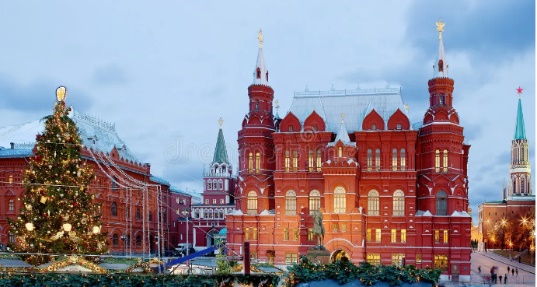 December/January: New Year
December/January: New Year
As Christmas was banned for many years in Russia, many of the Christmas traditions were diverted to the New Year celebrations on New Years’ Eve on 31 December. People now decorate New Year trees instead of Christmas trees and Father Frost, accompanied by his granddaughter Snow Maiden, delivers presents instead of Father Christmas. Families enjoy feasts, listen to the President’s New Year Speech and the Kremlin clock strikes midnight. Many Russians also celebrate a second New Year on 13–14 January or Old New Year, a tradition dating back to the old Julian calendar. Concerts, carnivals and street fairs – and a large ice rink in Red Square – are part of the fun.
Did you know that... the word Christmas comes from the Old English words which mean "the mass of Christ". That phrase was first used in 1038. The first festival recorded on December 25th was held by Romans in the fourth century. The celebration was later spread to other societies and cultures, giving origin to modern Christmas.
the word Christmas comes from the Old English words which mean "the mass of Christ". That phrase was first used in 1038. The first festival recorded on December 25th was held by Romans in the fourth century. The celebration was later spread to other societies and cultures, giving origin to modern Christmas.

Прочитайте приведённые ниже тексты. Преобразуйте, если необходимо, слова, напечатанные заглавными буквами в конце строк, обозначенных номерами 19–24, так, чтобы они грамматически соответствовали содержанию текстов. Заполните пропуски полученными словами. Каждый пропуск соответствует отдельному заданию из группы 19–24.
In 1843 Henry Cole, a senior civil servant at the post office, asked his friend John Horsley, who was an artist 19) ___ (MAKE) a card for him to send out at Christmas. The card had three panels. The outer two panels showed 20) ___ (PERSON) caring for the poor, and in the centre panel was a family 21) ___ (HAVE) a large Christmas dinner. Some people didn't like the card because it showed a child 22) ___ (GIVE) a glass of wine! About 1000 cards 23) ___ (PRINT) and sold. They are now very rare and cost 24) ___ (THOUSAND) of pounds or dollars to buy now! The idea seemed to catch on and soon many wealthy Victorian families were sending out their own cards.

Прочитайте приведённый ниже текст. Образуйте от слов, напечатанных заглавными буквами в конце строк, обозначенных номерами 25-29, однокоренные слова так, чтобы они грамматически и лексически соответствовали содержанию текста. Заполните пропуски полученными словами. Каждый пропуск соответствует отдельному заданию из группы 25-29.
The 25) _____(ABBREVIATE) Xmas for Christmas dates from the 16th century. The X 26) _______ (REPRESENT) the Greek letter "chi", which is also the first letter of the Greek word Χριστός 27) ______ (MEAN) Christ). The word Xmas 28) ____ (USE) in religious writing for many years. But it is now offensive to some people because it is considered a 29) _____ (COMMERCE) strategy to omit Christ from Christmas. Nowadays, it is used only in informal writing and on advertisements.
rate, the Christmas card industry took off.

Прочитайте текст с пропусками, обозначенными номерами 30-36. Эти
номера соответствуют заданиям 30-36, в которых представлены
возможные варианты ответов. Запишите в поле ответа цифру 1, 2, 3 или 4,
соответствующую выбранному Вами варианту ответа.
Christmas pudding
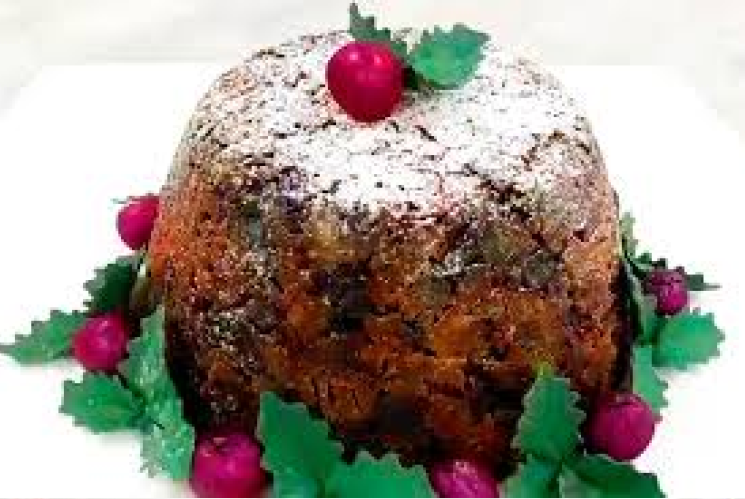

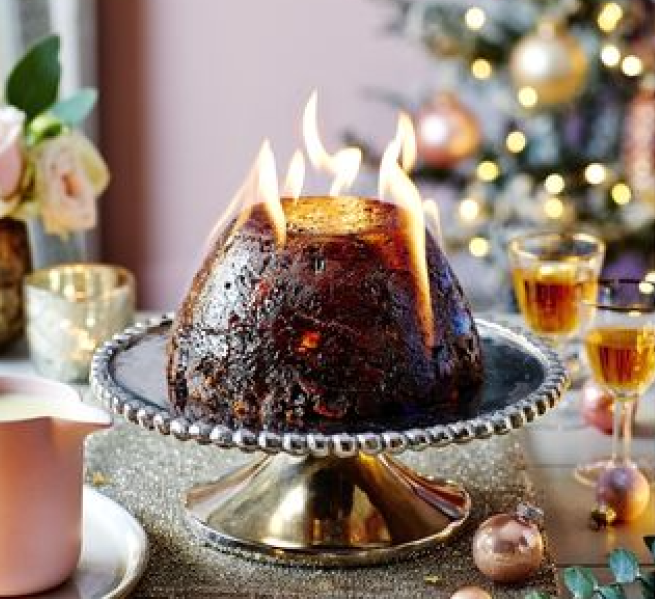
The very first version of the pudding 30) ___ in the 14th century. The British made porridge called "frumenty" made of beef and mutton with raisins, wines, currants, and spices – quite a 31) ___ of tastes! At that time pudding tended to be more like soup and was eaten in the time of Christmas preparation. By the end of the 14th century, *frumenty had gone 32) ___ several names including plum pudding, Christmas pudding, or just Pud! After the 16thcentury, dried fruit became more 33) ___, and the pudding slowly shifted from savoury to sweet. Plum pudding became the customary Christmas dessert around 1650, but in 1664 the Puritans in England 34) ___ to ban it as they considered it “sinfully rich”. In 1714, King George I 35) ___ it as part of the Christmas meal, having tasted and enjoyed Plum Pudding. Christmas pudding 36) ___ again became the customary dessert of a Christmas meal by the middle of the 17th century.
*frumenty ['fru:məntɪ]сладкая пшеничная каша на молоке с корицей
| 30. 1) came | 2) appeared | 3) originated | 4) began |
| 31. 1) collection | 2) number | 3) group | 4) amount |
| 32. 1) past | 2) from | 3) along | 4) through |
| 33. 1) accessible | 2) available | 3) obtainable | 4) welcoming |
| 34. 1) attempted | 2) wanted | 3) tried | 4) decided |
| 35. 1) replaced | 2) returned | 3) re-established | 4) introduced |
| 36. 1) once | 2) only | 3) all | 4) time |
Ответы:
30. ___, 31. ___, 32. ___, 33. ___, 34. ___, 35. ___, 36. ___


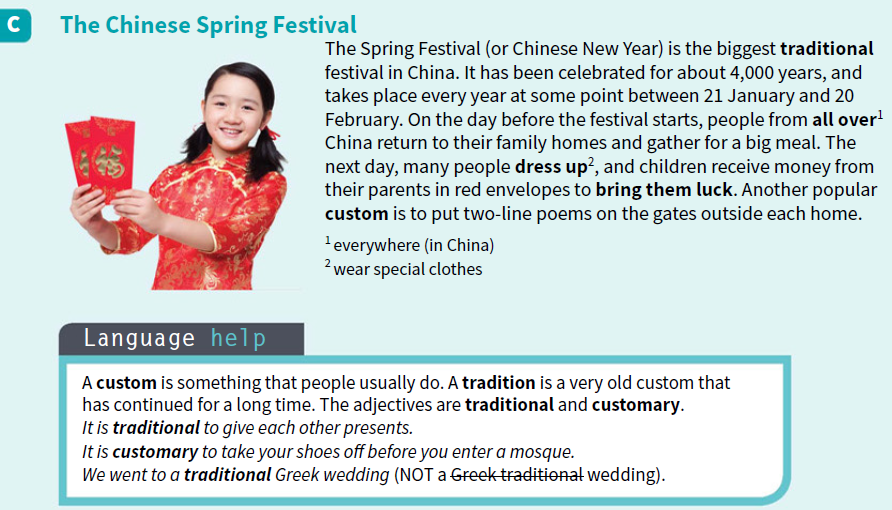
Exercises
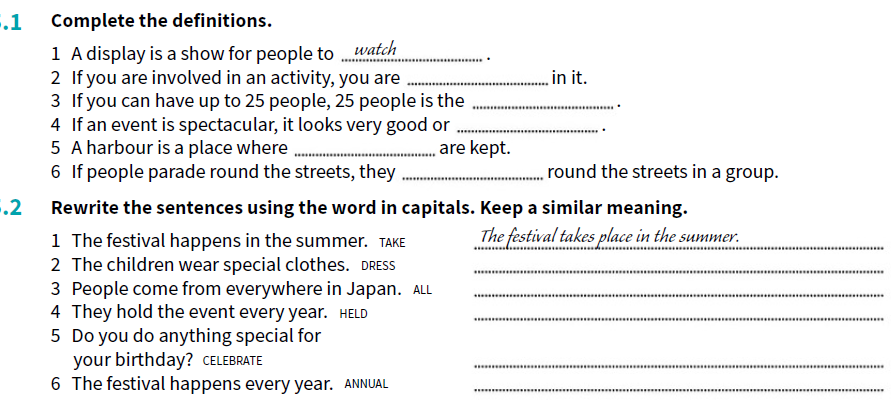
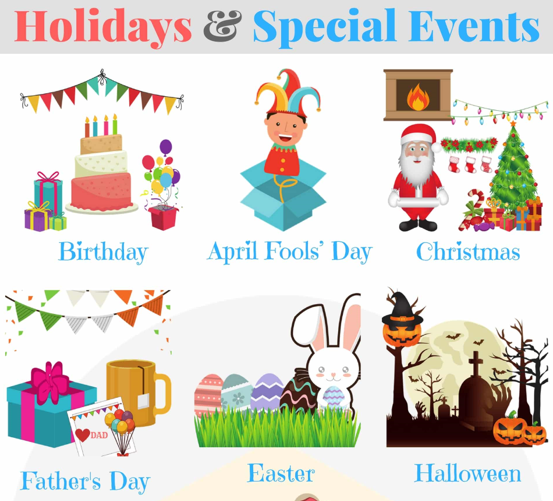
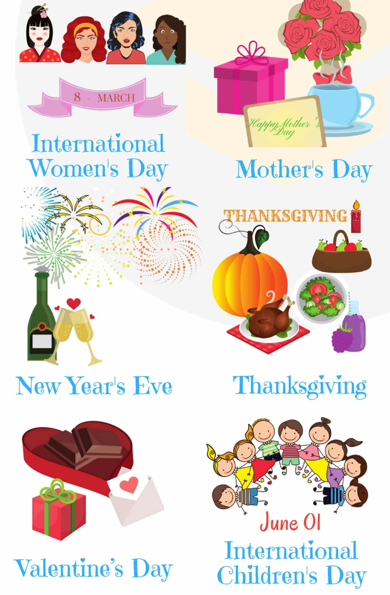
Celebrations in the UK

Прочитайте приведённые ниже тексты. Преобразуйте, если необходимо,
слова, напечатанные заглавными буквами в конце строк, обозначенных
номерами 19–24, так, чтобы они грамматически соответствовали
содержанию текстов. Заполните пропуски полученными словами. Каждый
пропуск соответствует отдельному заданию из группы 19–24.
“Remember, remember the 5th of November!”

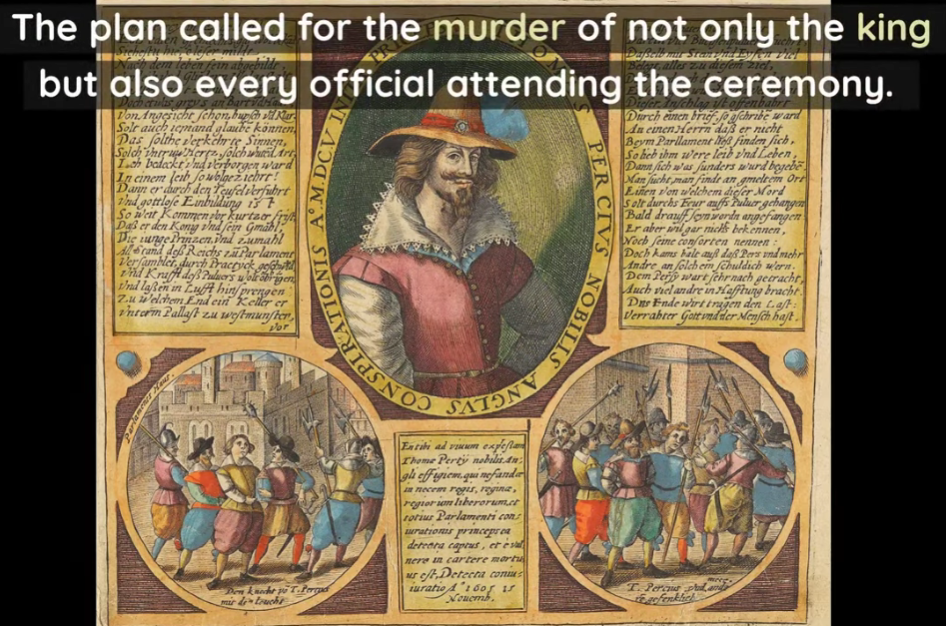

Guy Fawkes was born in Yorkshire in 1570. A convert to the Catholic faith, Fawkes 19) ____ (BE) a soldier who had spent several years 20) ____ (FIGHT) in Italy. It was during this period that he 21) ____ (ADOPT) the name Guido (Italian for Guy) perhaps to impress the 22) _____ (LADY)! What we do know is that Guido 23) ____ (ARREST) in the early hours of the morning of November 5th 1605, in a cellar under the House of Lords, next to the 36 kegs of gunpowder, with a box of 24) _____ (MATCH) in his pocket and a guilty expression on his face!

Прочитайте приведённый ниже текст. Образуйте от слов, напечатанных
заглавными буквами в конце строк, обозначенных номерами 25-29,
однокоренные слова так, чтобы они грамматически и лексически
соответствовали содержанию текста. Заполните пропуски полученными
словами. Каждый пропуск соответствует отдельному заданию из группы 25-29.


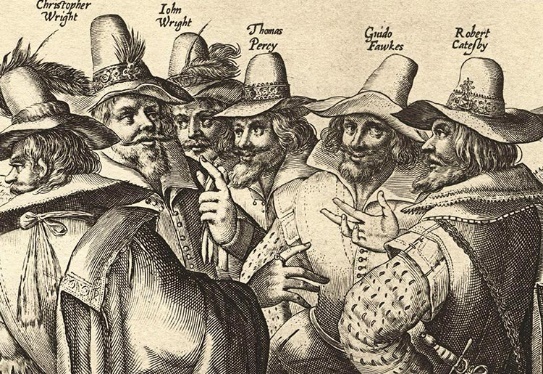
The 25) _____ (PLOT) rented a cellar under the palace, and Fawkes planted 36 barrels of gunpowder there and camouflaged them with coals and fagots. But the plot was discovered, and Fawkes was arrested (the night of November 4–5, 1605). Only after being tortured on the rack did he reveal the names of his accomplices. Tried and found 26) ____ (GUILT) before a special commission (January 27, 1606), Fawkes was to be executed opposite the Parliament 27) ____ (BUILD), but he fell or jumped from the gallows ladder and died as a result of having broken his neck. Nevertheless, he was quartered. The British 28) ______ (CELEBRATE) of Guy Fawkes Day (November 5) includes fireworks, 29) ____ (MASK) children begging “a penny for the guy,” and the burning of little effigies of the conspirator.

Прочитайте текст с пропусками, обозначенными номерами 30-36. Эти
номера соответствуют заданиям 30-36, в которых представлены
возможные варианты ответов. Запишите в поле ответа цифру 1, 2, 3 или 4,
соответствующую выбранному Вами варианту ответа.
Unbroken tradition?
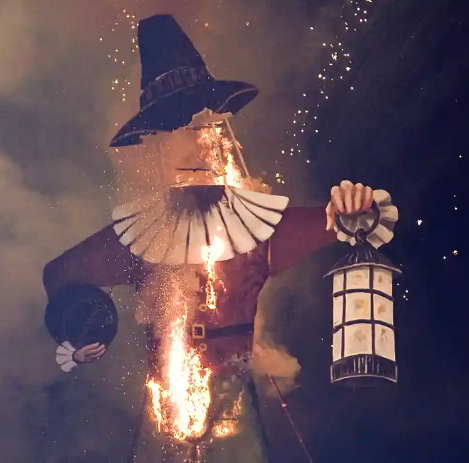
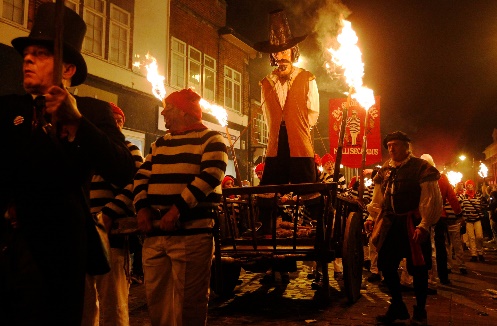
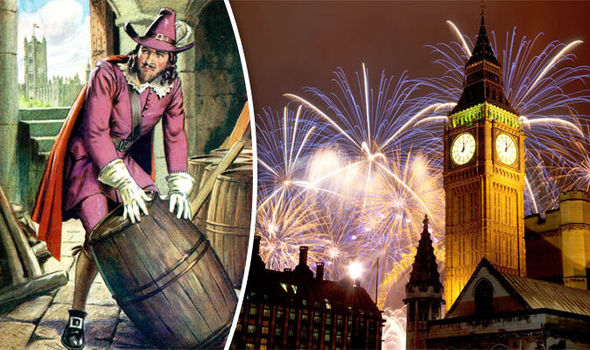
If Fawkes had succeeded in 30) ____ a match, he would have left an enormous explosion that would have destroyed Parliament, and scarred the surrounding buildings – not to mention the destruction of the 31) ____ political class. However, some experts now claim the gunpowder had ‘decayed’, and would have failed to 32) ____, even if properly ignited. The tradition to burn an effigy caught on pretty quickly. In the 1660s, effigies were 33) ____ with live cats in order to make it seem like the figure was screaming in the flames. Today, it’s a widespread tradition – apart 34) ____ at St. Peter’s School, York, Guy Fawkes’ alma mater. In honour of the ex-pupil, all celebrations are 35) ____. Perhaps the most surprising tribute to Guido is an uninhabited outcrop of the Galapagos Islands: Guy Fawkes Island. The origin of the name 36) ____ mysterious, but it may be a tribute to his years spent as a mercenary in the Spanish army.
| 30. 1) striking | 2) burning | 3) lighting | 4) setting |
| 31. 1) entire | 2) complete | 3) full | 4) total |
| 32. 1) blow | 2) burst | 3) bang | 4) explode |
| 33. 1) loaded | 2) filled | 3) stuffed | 4) packed |
| 34. 1) from | 2) for | 3) with | 4) within |
| 35. 1) cancelled | 2) forgone | 3) forbidden | 4) forgotten |
| 36. 1) stays | 2) remains | 3) holds | 4) keeps |
Ответы: 30. ___, 31. ___, 32. ___, 33. ___, 34. ___, 35. ___, 36. ___
Task 1. Imagine that you are preparing a project with your friend. You have found some interesting material for the presentation and you want to read this text to your friend. You have 1.5 minutes to read the text silently, then be ready to read it out aloud. You will not have more than 1.5 minutes to read it.
 the Magi plural! /ˈmeɪdʒaɪ/- in the Bible, the three men who followed a star to visit Jesus Christ when he was a baby and give him presents. They are also called the Three Kings or the Three Wise Men (волхвы)
the Magi plural! /ˈmeɪdʒaɪ/- in the Bible, the three men who followed a star to visit Jesus Christ when he was a baby and give him presents. They are also called the Three Kings or the Three Wise Men (волхвы)

Gift-giving in general is an ancient tradition that came to be associated with the Christian feast of Christmas. In ancient Rome, gift giving might have occurred near the winter solstice in December which was celebrated during the Saturnalia holiday. As Christianity became increasingly widespread in the Roman lands, the custom of gift-giving occurred on New Year's Day. Around 336 AD, the date December 25 appears to have become established as the day of Jesus's birth, and the tradition of gift-giving was tied to the story of the Biblical Magi giving gifts to baby Jesus. Together with another story, that of Saint Nicholas, a fourth-century Christian bishop and gift-giver, it slowly became a part of Christmas celebrations in countries such as the United Kingdom.
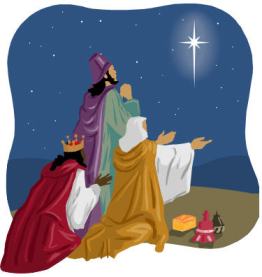
Task 2. Study the advertisement
“If you care, express it by gifts!”

You are considering having your Christmas presents wrapped and now you’d like to get more information. In 1.5 minutes, you are to ask four direct questions to find out about the following:
1. variety of gift-wrapping materials
2. possibility of wrapping fragile items
3. range of coloured ribbons
4. cost of packaging

| Tapescript for Task 3
Interviewer: Hello everybody! It’s Teenagers Round the World Channel. Our guest today is a teenager from Russia and we are going to talk about original English holidays celebrated in Russia. We’d like to know our guest’s point of view on this issue. Please answer five questions. So, let’s get started.
Interviewer: What original English holidays do teenagers in Russia celebrate? Student: ______________________________________________
Interviewer: Is Halloween popular with your peers? Why/ why not? Student: _____________________________________________
Interviewer: Have you ever decorated your English classroom on Halloween? What kind of decorations were they? Student: _________________________________________________
Interviewer: Do you like the tradition of trick-or-treating? Why/ why not? Student: ________________________________________________
Interviewer: Do you think it’s a good idea to celebrate other countries’ holidays in Russia? Explain your thought. Student: ______________________________________________
Interviewer: Thank you very much for your interview. |
Task 4. Imagine that you and your friend are doing a school project “Events and holidays celebrated in the English-speaking countries”. You have found some illustrations and want to share the news. Leave a voice message to your friend. In 2.5 minutes be ready to:
• explain the choice of the illustrations for the project by briefly describing them and
noting the differences;
• mention the advantages (1–2) of celebrating these holidays;
• mention the disadvantages (1–2) of celebrating these holidays;
• express your opinion on the subject of the project – which holiday you’d like to celebrate with your friends in Russia and why.
You will speak for not more than 3 minutes (2–3 sentences for every item of
the plan, 12–15 sentences total). You have to talk continuously.

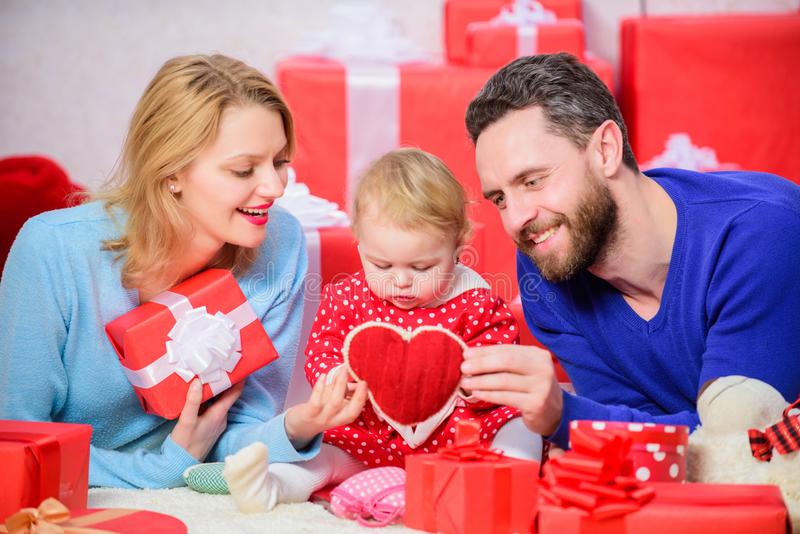
Let’s talk about festivals.
1. What are the important festivals where you come from?
2. How do people celebrate these festivals?
3. Do young people or older people enjoy these festivals more?
4. Do you think people will still celebrate these festivals in the future?
5. What are the most important traditions that people in your country follow (e.g. eating
habits, greetings, holidays)
6. Do young people still learn about traditions and customs? Is this a good thing or a
bad thing?
7. How important is it for a culture to maintain its traditions, in your view?
8. In the future, will it be possible for countries to preserve their cultural traditions?
9. At what age do people begin to celebrate birthdays?
10. How do people in your country celebrate birthdays?
11. Do you eat special food on birthdays?
12. Do you celebrate the birthdays of important people in your society? (leaders/heroes)
37. You have received an email message from your English-speaking pen-friend Ronny:
| From: Ronny@mail.uk |
| To: Russian_friend@ege.ru |
| Subject: Celebrations |
| …I have just come back from our annual celebration of Maslenitsa. It was arranged at our school stadium where we burnt a straw doll, ate delicious pancakes and drank freshly-made strong tea. I loved the event! What celebration is your favourite? How do you usually celebrate it? Is it a day off in your country? By the way, my mum shared her secret recipe for pancakes with me for Maslenitsa. My classmates said they were yummy)) |
Write an email to Ronny. In your message:
- answer his questions;
- ask 3 questions about the recipe for pancakes.
Write 100–140 words. Remember the rules of email writing.
38. Imagine that you are doing a project on what celebrations are popular with teenagers in Zetland. You have found some data on the subject – the results оf the opinion polls (see the table below). Comment on the data in the table and give your opinion on the subject of the project.
| Celebrations
| Number of respondents (%) |
| Christmas
| 52% |
| Easter
| 18% |
| St. Valentine’s Day
| 16% |
| Thanksgiving Day
| 8% |
| Halloween
| 6% |
Write 200–250 words.
Use the following plan:
– make an opening statement on the subject of the project;
– select and report 2–3 facts;
– make 1–2 comparisons where relevant and give your comments;
– outline a problem that can arise with setting fireworks on some special celebrations and suggest a way of solving it;
– conclude by giving and explaining your opinion on the importance of keeping alive national traditions in our lives.
Пример выполнения задания
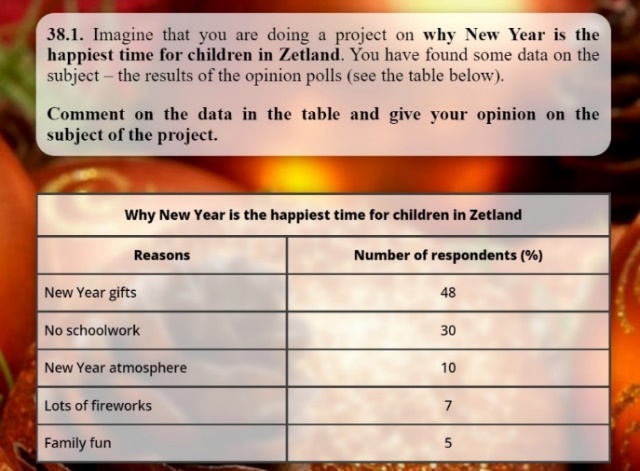
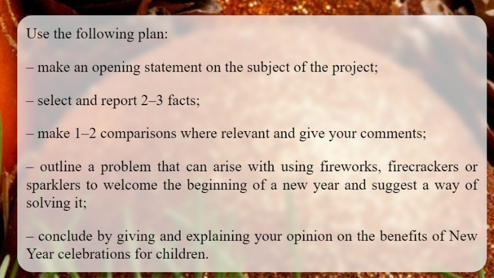
New Year is a holiday many people, especially young children, look forward to. Currently, I am working on my project to find out why New Year is the happiest time for children in Zetland. As part of my project, I have found a table with the results of the opinion polls on the subject and in this essay, I am going to analyze the data.
It is clear from the table that receiving New Year gifts comes first in popularity chosen by almost half of the respondents (48%). Another group of those polled (10%) adore New Year due to its fairy atmosphere filled with magic. A slightly smaller share of those surveyed (7%) like setting off fireworks to see New Year in.
A more detailed examination of the data in the table reveals that no schoolwork is six times as popular option as having family fun (30% and 5% respectively). It comes as no surprise because hanging out with peers and sharing a festive mood together is more preferable and appealing to children than celebrating New Year in their family circle.
It is worth noting that some problems can arise with using fireworks, firecrackers or sparklers to welcome the beginning of a new year. One of them is neglecting safety rules which can lead to getting burns. The best solution to this problem is strict observing manufacturers’ instructions and making all guests, especially children, keep a safe distance.
In conclusion, I strongly believe that New Year celebrations are highly beneficial for children as they give them a lot of joy and fun. This happy time is sure to stay in their memory forever.
273
Ответы:
Christmas
19 – TO MAKE, 20 – PEOPLE, 21 – HAVING, 22 – BEING GIVEN, 23 – WERE PRINTED, 24 – THOUSANDS, 25 – ABBREVIATION, 26 – REPRESENTS, 27 – MEANING, 28 – HAS BEEN USED, 29 – COMMERCIAL
| 30. 1) came | 2) appeared | 3) originated | 4) began |
| 31. 1) collection | 2) number | 3) group | 4) amount |
| 32. 1) past | 2) from | 3) along | 4) through |
| 33. 1) accessible | 2) available | 3) obtainable | 4) welcoming |
| 34. 1) attempted | 2) wanted | 3) tried | 4) decided |
| 35. 1) replaced | 2) returned | 3) re-established | 4) introduced |
| 36. 1) once | 2) only | 3) all | 4) time |
Exercises

“Remember, remember the 5th of November!” (Guy Fawkes)
19 – HAD BEEN, 20 – FIGHTING, 21 - ADOPTED, 22 – LADIES, 23– WAS ARRESTED, 24 – MATCHES, 25 – PLOTTERS, 26 – GUILTY, 27 – BUILDING, 28 – CELEBRATION, 29 – MASKED
| 30. 1) striking | 2) burning | 3) lighting | 4) setting |
| 31. 1) entire | 2) complete | 3) full | 4) total |
| 32. 1) blow | 2) burst | 3) bang | 4) explode |
| 33. 1) loaded | 2) filled | 3) stuffed | 4) packed |
| 34. 1) from | 2) for | 3) with | 4) within |
| 35. 1) cancelled | 2) forgone | 3) forbidden | 4) forgotten |
| 36. 1) stays | 2) remains | 3) holds | 4) keeps |


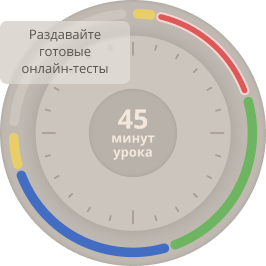




 Christmas
Christmas  long with other religious celebrations, Christmas was banned in Russia after the 1917 Revolution. Russians could only openly observe Christmas in 1992. Almost all Russians celebrate Christmas (the birth of Jesus) on 7 January. It’s mainly a religious occasion and also a public holiday in Russia when families gather together to attend church services on Christmas Eve (6 January). They then go home to feast on a special holy supper. The Christmas Eve meal is typically meatless and can be made up of twelve dishes to represent the twelve apostles. Kutya as one of the main dishes of the Christmas feast is a concoction of grains and poppy seeds sweetened with honey; it is served as one of the main dishes of the Christmas feast. Russian Christmas is spent with family, and is considered a time of forgiveness and love. Thoughtful gifts are given to loved ones, and homes are decorated with figures of angels, stars, and nativity scenes.
long with other religious celebrations, Christmas was banned in Russia after the 1917 Revolution. Russians could only openly observe Christmas in 1992. Almost all Russians celebrate Christmas (the birth of Jesus) on 7 January. It’s mainly a religious occasion and also a public holiday in Russia when families gather together to attend church services on Christmas Eve (6 January). They then go home to feast on a special holy supper. The Christmas Eve meal is typically meatless and can be made up of twelve dishes to represent the twelve apostles. Kutya as one of the main dishes of the Christmas feast is a concoction of grains and poppy seeds sweetened with honey; it is served as one of the main dishes of the Christmas feast. Russian Christmas is spent with family, and is considered a time of forgiveness and love. Thoughtful gifts are given to loved ones, and homes are decorated with figures of angels, stars, and nativity scenes. February: Maslenitsa Festival
February: Maslenitsa Festival even weeks before Easter are the week-long Maslenitsa festivities – Russia’s pancake week. They combine the pagan tradition of marking the transition from winter to spring with the Christian tradition of feasting before Lent. Each day there are different activities: making Maslenitsa dolls from straw and old clothes, making and eating lots of pancakes (blinis), sledging, playing on seesaws, singing, fistfights, visiting relatives, exchanging gifts and feasting. The Maslenitsa dolls burn on the final day, and people jump over bonfires. Celebrations start the night before Easter Sunday. Churches fill with lights and, at dawn, the bells ring out to announce the arrival of Easter. Everyone paints boiled eggs in bright colors and has a traditional feast.
even weeks before Easter are the week-long Maslenitsa festivities – Russia’s pancake week. They combine the pagan tradition of marking the transition from winter to spring with the Christian tradition of feasting before Lent. Each day there are different activities: making Maslenitsa dolls from straw and old clothes, making and eating lots of pancakes (blinis), sledging, playing on seesaws, singing, fistfights, visiting relatives, exchanging gifts and feasting. The Maslenitsa dolls burn on the final day, and people jump over bonfires. Celebrations start the night before Easter Sunday. Churches fill with lights and, at dawn, the bells ring out to announce the arrival of Easter. Everyone paints boiled eggs in bright colors and has a traditional feast. 

 9 May: Victory Day
9 May: Victory Day White Nights Festival, St Petersburg (May-July)
White Nights Festival, St Petersburg (May-July)
 This is a summer solstice celebration. Girls wear flower or herb wreaths on their heads, and in the evening the wreaths are decorated with burning candles and set afloat; the girl whose wreath travels the farthest will have the happiest year ahead, and the candle that burns the longest means a long life. People light bonfires and jump over them for good luck. Some seek a special flowering fern said to direct the finder towards treasure. There are fireworks, of course.
This is a summer solstice celebration. Girls wear flower or herb wreaths on their heads, and in the evening the wreaths are decorated with burning candles and set afloat; the girl whose wreath travels the farthest will have the happiest year ahead, and the candle that burns the longest means a long life. People light bonfires and jump over them for good luck. Some seek a special flowering fern said to direct the finder towards treasure. There are fireworks, of course. December/January: New Year
December/January: New Year the word Christmas comes from the Old English words which mean "the mass of Christ". That phrase was first used in 1038. The first festival recorded on December 25th was held by Romans in the fourth century. The celebration was later spread to other societies and cultures, giving origin to modern Christmas.
the word Christmas comes from the Old English words which mean "the mass of Christ". That phrase was first used in 1038. The first festival recorded on December 25th was held by Romans in the fourth century. The celebration was later spread to other societies and cultures, giving origin to modern Christmas.

































